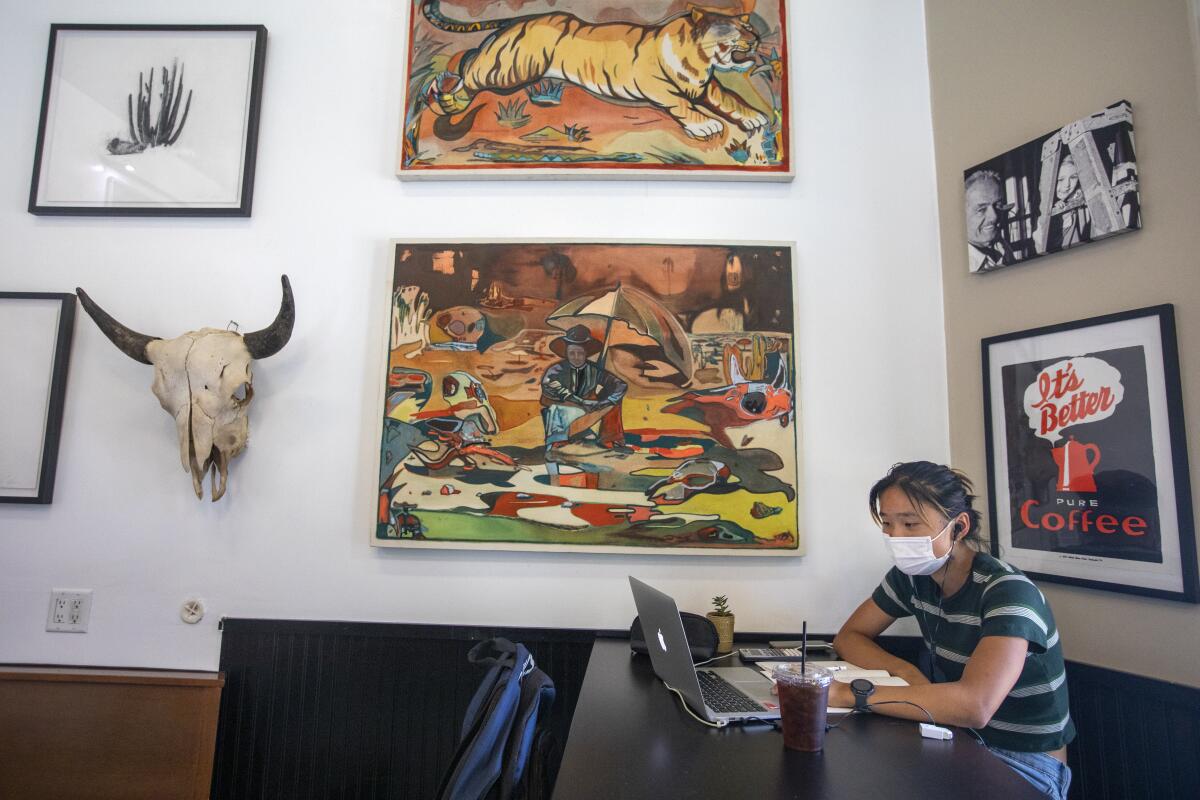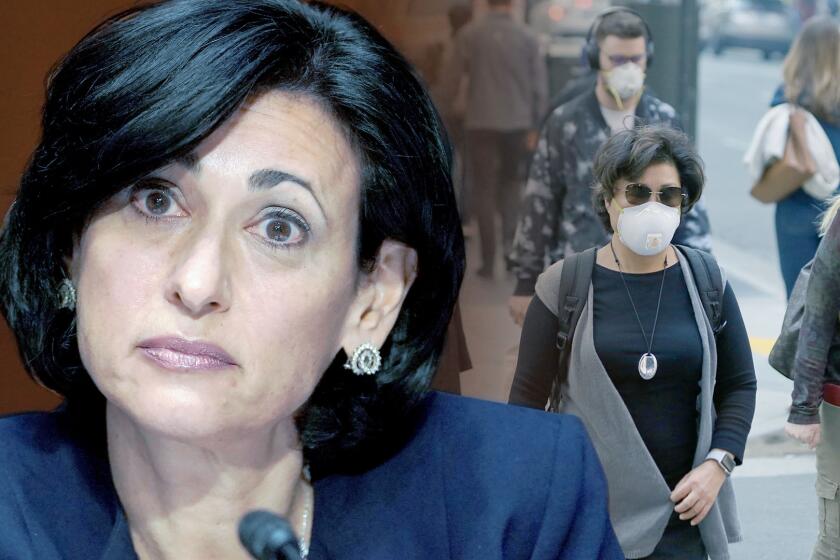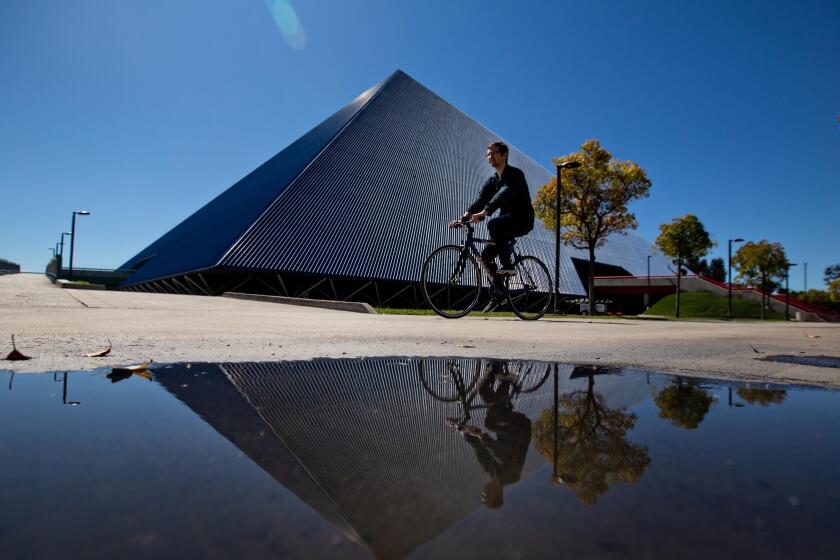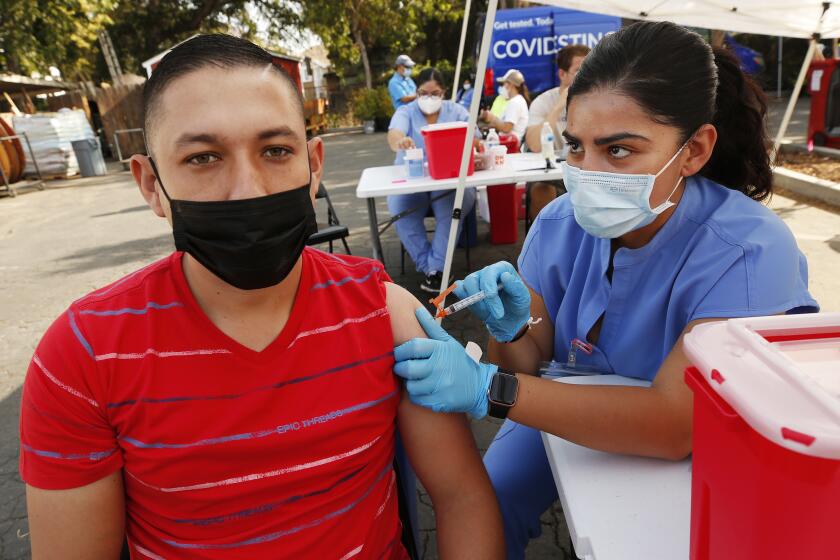California considers indoor mask rules after CDC’s recommendation

- Share via
California health officials are reviewing federal guidance that residents who are fully vaccinated against COVID-19 should resume wearing masks in indoor public settings in regions with elevated levels of coronavirus transmission, but have not yet decided whether to alter the state’s rules to match.
“We are doing a full review of the updated recommendations released by the [U.S. Centers for Disease Control and Prevention] today and will evaluate existing guidance to determine the best path forward to protect Californians from the spread of COVID-19 and the highly contagious Delta variant,” the California Department of Public Health wrote Tuesday afternoon in response to an email inquiry from The Times.
The CDC on Tuesday issued new guidance that vaccinated people should return to wearing masks indoors in public settings in parts of the country where the coronavirus is widely spreading.
Specifically, the federal agency is now advising that residents mask up in such situations in places where community spread is considered “substantial” or “high” — the two worst classifications on the agency’s four-tier scale.
The CDC recommends that even vaccinated people wear masks indoors in parts of the U.S. where the coronavirus is surging.
Most of California fell into one of those categories as of Tuesday afternoon, including the entire southern third of the state, save for San Luis Obispo County.
Many Californians live in areas that already recommend or, in the case of Los Angeles County, require that all residents wear masks in indoor public places.
Face coverings also will be required in such spaces in Yolo County starting Friday, officials said this week.
During a news conference shortly before the new guidance was announced, Gov. Gavin Newsom said the state would review the details when they became available and “make some comments in very short order.”
He noted, however, that “we’ve been working hand in glove with the CDC — or face to mask with the CDC — for some time.”
California State University — the nation’s largest four-year public university system — will require COVID vaccinations for students, faculty and staff.
California’s existing masking rules align with those previously issued at the federal level. Generally speaking, fully vaccinated Californians are allowed to largely go without face coverings, while the unvaccinated still need to mask up indoors while in public.
There are some settings in which everyone — regardless of vaccination status — must wear masks. Those include transit hubs or while aboard public transportation; in healthcare settings and long-term care facilities; indoors at K-12 schools, child-care facilities or other youth settings; in homeless shelters, emergency shelters and cooling centers; and in correctional facilities and detention centers.
Newsom has been pressed repeatedly on the possibility of issuing a new statewide mask mandate or recommendation in recent weeks, and has consistently responded that such measures won’t be necessary if more people get vaccinated.
“I encourage folks to get vaccinated,” he told reporters Monday. “That’s our focus.”
With cases and hospitalizations spiking, the focus is increasingly on ramping up vaccinations to protect as many people as possible against infection and illness.
California, like much of the country, is working to beat back a significant and sustained increase in coronavirus infections and COVID-19 hospitalizations.
Over the past week, the state has reported an average of nearly 7,000 new coronavirus cases a day — more than six times the rate from a month ago, according to data compiled by The Times.
On Monday, 3,200 coronavirus-positive patients were hospitalized statewide, with 720 of them in intensive care.
Both those figures have doubled in the past two weeks, and Newsom said the state isn’t anticipating that trend reversing anytime soon.
“Our projections are sobering,” he told reporters Monday. “Our projections are, over the course of the next number of weeks, we’ll show a significant increase in hospitalizations if we continue down this path.”
Despite the steep recent increases, California remains in far better shape than during the height of the fall and winter surge, when the state was recording an average of more than 40,000 daily cases, and nearly 22,000 coronavirus-positive patients were hospitalized on some days.
COVID-19 deaths also have remained relatively low — at about 22 per day, on average.
Fatalities are the ultimate lagging indicator of coronavirus spread, and sometimes it takes weeks for increases in infections to trigger a resulting rise in deaths. However, some officials have expressed optimism that the domino effect may not materialize in the same way this time around, given how many Californians have already been vaccinated.
Officials have also stressed that the vast majority of new cases are occurring in those who have yet to get their shots.
“People who are not vaccinated are driving up cases and hospitalizations in California, and we urge everyone who is eligible to get vaccinated now so we can keep our kids in school and businesses open,” state health officials wrote in their statement to The Times.
According to the California Health and Human Services Agency, the latest coronavirus case rate among unvaccinated residents is thought to be above 14 per 100,000 people — roughly seven times the rate for those who are fully vaccinated.
And more than 97% of people now hospitalized for COVID-19 nationally have not been vaccinated, according to CDC Director Dr. Rochelle Walensky.
Nearly 61% of all Californians have received at least one dose to date, and 53% are fully vaccinated, Times’ data show.
However, that still leaves millions of people who have either not yet rolled up their sleeves, or are not yet eligible to do so. This significant slice of the population, officials and experts say, remains vulnerable to infection and illness — particularly given the rapid spread of the Delta variant.
Roughly 83% of coronavirus cases that have been analyzed in July involved the Delta variant, up from about 53% in June, according to the latest data released by the California Department of Public Health.
That strain, L.A. County Public Health Director Barbara Ferrer warned over the weekend, is “one of the most aggressive and infectious respiratory diseases known.”
As part of its effort to reverse the rising tide of cases, California will require all state employees — as well as workers in public and private healthcare facilities and congregate settings such as jails, homeless shelters and senior living homes — to show proof they’ve been vaccinated against COVID-19, starting next month.
Those who are unvaccinated, or decline to provide the requested documentation, will be subjected to regular testing and have to wear masks while working indoors.
“We are sincere in our belief and desire that we need to step things up at this stage of the pandemic,” Newsom said.
More to Read
Sign up for Essential California
The most important California stories and recommendations in your inbox every morning.
You may occasionally receive promotional content from the Los Angeles Times.













